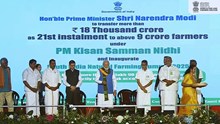
Potatoes are a staple in millions of Indian households, but when it came to making French fries, farmers faced a major gap. The varieties available didn’t quite meet the specific needs of the frozen French fry industry, which relies on potatoes with the right size, shape, sugar levels, and dry matter content. While options like Kufri Chipsona-1 and Kufri Surya offered some advantages, they fell short of delivering consistent results across different growing conditions.
Addressing this challenge, the Central Potato Research Institute (CPRI) developed Kufri Frysona—a high-yielding potato variety specially bred for French fry production, marking a practical step forward for both farmers and food processors.
To fill this gap, the CPRI, Kufri began working on a new variety, initiating crossbreeding programs as early as 1998. Kufri Frysona, initially tested under the code MP/98-71, emerged as a promising candidate. It was derived from a cross between two processing-type hybrids (MP/92-30 x MP/90-94), and after a decade of multi-location trials, laboratory tests, and on-farm experiments, it was released for commercial cultivation in 2009 for the states of Uttar Pradesh, Punjab, Haryana, and West Bengal.
What Makes Kufri Frysona Special?
Kufri Frysona is uniquely engineered for French fry production. It yields long, oblong, white-fleshed tubers with shallow eyes, ideal for producing uniformly shaped fries with minimal peeling loss. One of its key advantages is its longer tuber dormancy, which helps in prolonged storage without early sprouting, an essential trait for both farmers and processors who require flexibility in harvesting and supply management.
Additionally, the variety exhibits strong field resistance to late blight, a notoriously destructive potato disease that can wipe out entire crops under favorable conditions. This resistance reduces the need for frequent fungicide applications, thereby lowering production costs and minimizing environmental impact.
Collectively, these attributes position Kufri Frysona not merely as another potato variety but as a purpose-bred, high-performance solution tailored to meet the evolving needs of India’s growing potato processing industry.
Performance in the Field
Over five years of evaluation at Modipuram and two years of testing across seven AICRP (All India Coordinated Research Project) locations, Kufri Frysona consistently outperformed existing varieties in yield and quality. It recorded a 25.6% higher total yield compared to Kufri Surya and an impressive 59.6% higher yield of French fry-grade tubers than Kufri Chipsona-1. One of the standout features of Kufri Frysona is its superior tuber size distribution, producing a larger proportion of oblong tubers exceeding 75mm, ideal for French fry processing.
This characteristic not only enhances marketability but also ensures better returns for farmers. The variety has been successfully adopted by cultivators in states like Uttar Pradesh and Madhya Pradesh, with notable performance reported from regions such as Patna, Ghaziabad, and Indore, where it consistently outperformed traditional cultivars in both yield and quality.
Industrial and Laboratory Validation
Industrial-scale trials conducted by leading processors such as M/S Wimpy International in Gurgaon and M/S Satnam Agri. Products in Jalandhar validated the laboratory findings and reinforced Kufri Frysona's suitability for commercial French fry production. These trials revealed that fries made from Kufri Frysona exhibited excellent color, crispness, and texture, key attributes demanded by consumers and processors alike.
The variety also showed minimal oil absorption and no sogginess, even after extended frying, indicating its strong performance under industrial frying conditions. Moreover, the tubers consistently contained more than 21% solids, which translated into better product recovery, reduced frying time, and lower energy consumption. Collectively, these traits affirm Kufri Frysona’s compatibility with modern processing lines and position it as a promising alternative to imported or less suitable domestic potato varieties.
Storage and Shelf Life
One of the major challenges in potato processing is ensuring effective storage, as many traditional varieties tend to sprout or deteriorate quickly under ambient conditions. Kufri Frysona, however, has demonstrated excellent storage behavior that addresses this issue effectively. It recorded low sprout weight and minimal overall weight loss even after 90 days at room temperature, showcasing its natural resilience.
Additionally, it maintained good keeping quality without refrigeration and delivered excellent results under cold storage conditions (10–12°C) for up to five months when treated with CIPC, a common sprout suppressant. These attributes significantly benefit processors by allowing for more efficient inventory planning and ensuring a steady supply of raw material throughout the year.
Kufri Frysona: Agronomic Recommendations
Kufri Frysona performs optimally when planted during the second fortnight of October, aligning well with the main season crop cycle in the north-central plains of India. To achieve maximum yield of French fry-grade tubers, a specific crop geometry is recommended: 67.5 cm spacing between rows and 25 cm between plants within each row. This layout promotes better plant growth and tuber development.
The ideal fertilization regimen includes 270 kg of nitrogen, 80 kg of phosphorus (P₂O₅), and 150 kg of potassium (K₂O) per hectare. Importantly, nitrogen should be applied in two equal splits, once at planting and the remainder during earthing up to ensure optimal nutrient availability during key growth stages. While these recommendations are tailored to the north-central plains, they can be adapted based on local soil and climatic conditions in other regions.
Broader Impact on Indian Agriculture and Industry
Kufri Frysona is more than a scientific achievement, it represents a bridge between traditional farming and modern food processing. Its release supports several national priorities:
-
Import substitution: Reducing dependence on foreign varieties.
-
Income diversification: Giving farmers access to premium buyers in the processing industry.
-
Rural development: Creating value-added agri-supply chains and employment in semi-urban areas.
-
Export potential: With global quality standards met, this variety could serve as an export commodity.
Kufri Frysona is a breakthrough in Indian agriculture, bridging traditional farming and modern processing needs. By boosting yields, reducing import dependence, and supporting rural livelihoods, it empowers farmers and strengthens India’s food economy. Its quality and performance make it ideal for both domestic use and export, marking a step toward a self-reliant agri-food system.
















